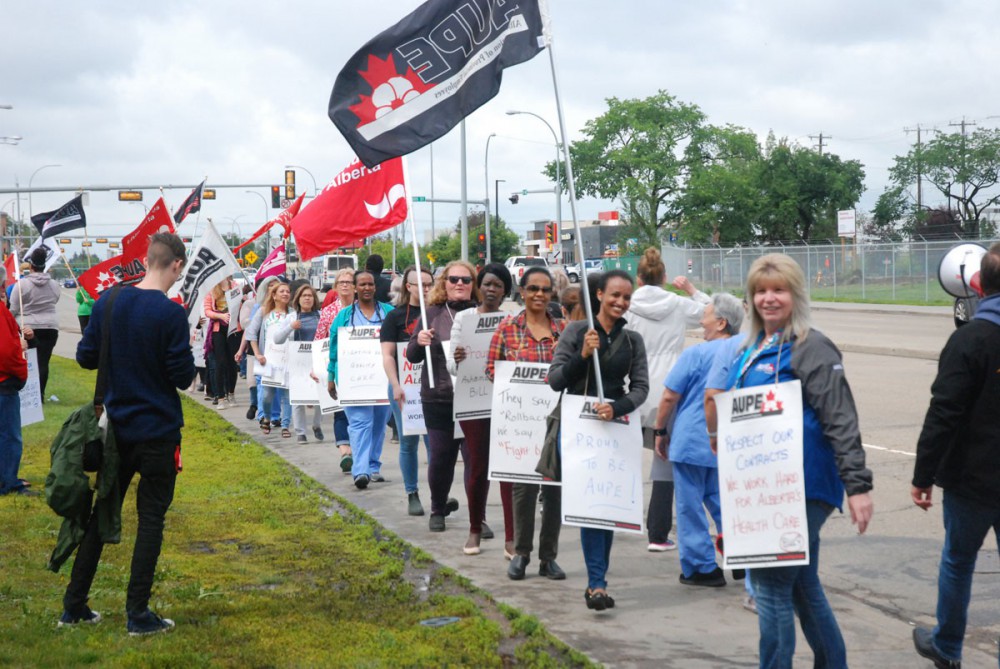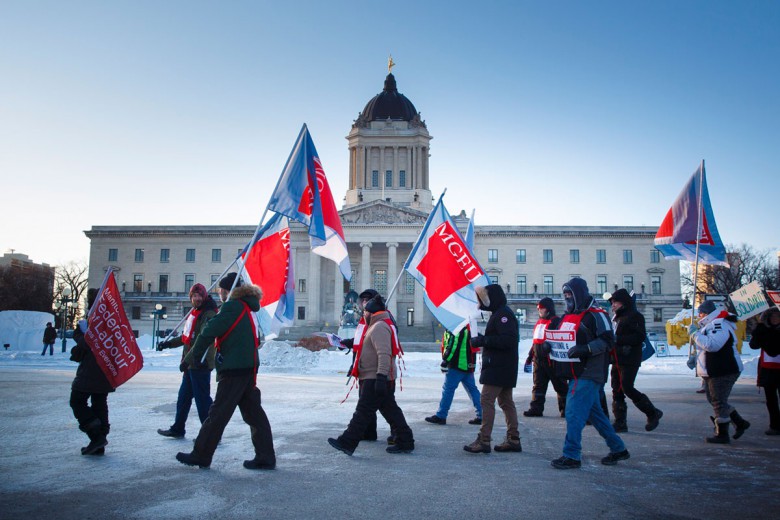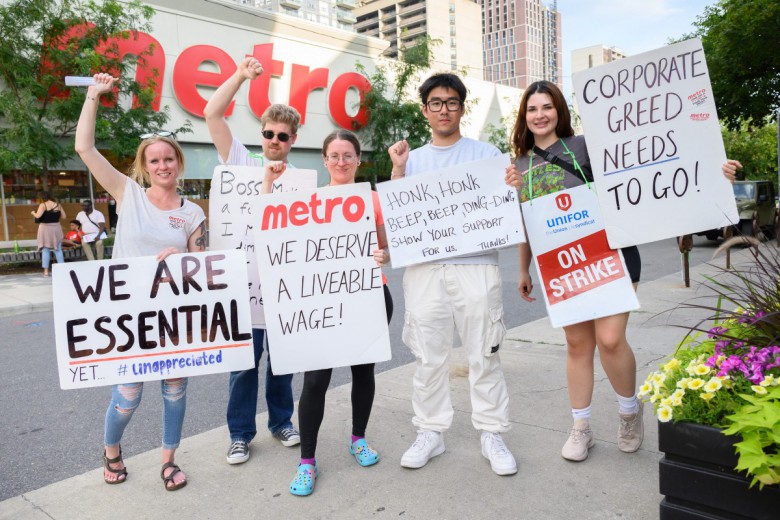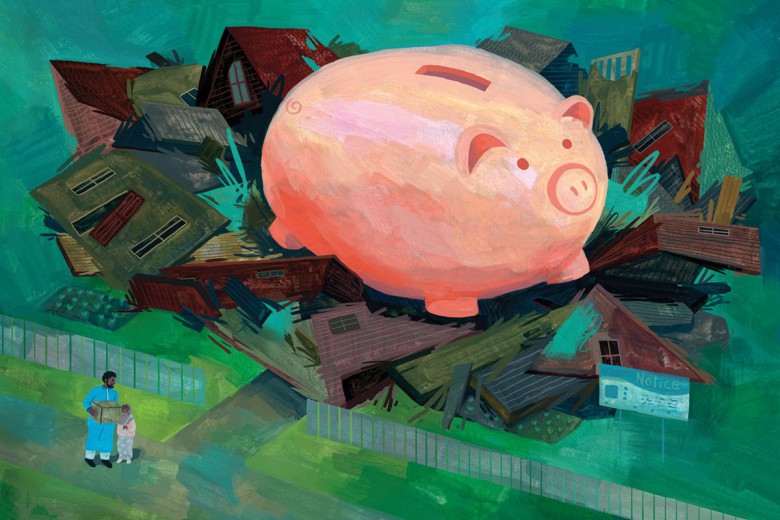Writer’s note: Since this article was published in print on October 21, 2019, the United Conservative Party has released its 2019 budget. When taking into account inflation and population growth, the budget follows through on immediate cuts to cities, education, social services, healthcare, and post-secondary education, while reducing corporate taxes by 33 per cent over four years.
The public reaction has been one of shock and disbelief, and government MLAs – who spent months accusing the opposition MLAs of stoking “fear and smear” about cuts – have now largely retreated from public view. Public sector layoffs have apparently already begun and can be expected for years to come as several public sector unions return to the bargaining table with a hostile government in 2020. The first order of business for organized labour should be to use the momentum from the summer of solidarity to launch a largely unprecedented fightback effort.
On June 13, Jason Kenney’s newly elected United Conservative government introduced Bill 9, the Public Sector Wage Arbitration Deferral Act. The bill sought to defer negotiations over wages for 180,000 teachers, nurses, and government workers until the end of October.
With the introduction of Bill 9, Alberta’s labour leaders came out swinging with a slate of dramatic statements. Heather Smith, president of the United Nurses of Alberta (UNA), did not mince her words: “Even Ralph Klein, in the depths and darkness of the 1990s, didn’t use legislation to reach in and violate workers’ contracts. This is incredibly unprecedented, incredibly disappointing. It is the biggest betrayal by the government I have ever seen.”
Even so, the bill became law shortly thereafter, on June 28.
This was just the first round of a major fight between public-sector workers and Kenney’s hardline right-wing government. It’s a battle that has the potential to be one for the ages, since it is likely that the Kenney government plans to follow it up by trying to decrease public-sector wages. Bill 9 sends a direct message that the Kenney government has set its sights on attacking public servants – who are largely women – and the crucial services they offer to all Albertans.
The battle lines are clear
Bill 9 applies to specific collective agreements – but since it sets a precedent of the government wilfully violating negotiated collective agreements, it has dire implications for all public-sector unions. During Rachel Notley’s NDP government, public-sector unions such as the Alberta Union of Provincial Employees (AUPE) and UNA agreed to a pattern of a roughly zero per cent pay increases for two years in return for a binding wage reopener in the third year – which falls in 2019 for many of the unions.
As the UNA website explains, “A wage reopener allows only the wage portion of [a collective] agreement to be reopened for negotiation while all other parts of the contract remain in place.” In February 2019, UNA had already begun calling for a 3 per cent wage increase in anticipation of the reopener. When an agreement couldn’t be reached with employers, an arbitrator was appointed to end the impasse, with hearings to be held by June 30. But that didn’t happen, as the Labour Relations Board put the arbitration hearings on hold in mid-May after being instructed by the new government do so, even prior to it being sworn into office.
Bill 9 sends a direct message that the Kenney government has set its sights on attacking public servants – who are largely women – and the crucial services they offer to all Albertans.
On June 24, AUPE filed for a court injunction to allow wage arbitration to go ahead, stating that Bill 9 represents bad-faith bargaining and violates the Charter of Rights and Freedoms. A month later, Justice Eric Macklin granted the temporary injunction, and the Kenney government immediately stated its intention to appeal the decision in an expedited hearing. And, while arbitration hearings did begin in early August with AUPE, the Alberta Court of Appeal overturned the injunction in early September, once again making Bill 9 the law of the land. AUPE may seek leave to appeal to the Supreme Court of Canada.
Bill 9 deferred previously negotiated wage reopeners until October 31 – that is, after the government held the so-called “Blue Ribbon Panel on Alberta’s Finances,” led by former Saskatchewan NDP cabinet minister turned conservative activist Janice MacKinnon.
That panel completed its work and the full report was released in September. The report was designed to develop the story that, as it says, “today’s fiscal crisis is arguably far worse than [that] faced by the Alberta government in the early 1990s” – that is, we live in exceptional times that warrant more privatization, salary increases for “non-bargaining” public service staff (out-of-scope managers), and “alternative” (e.g., not-for-profit) delivery of services.
The panel wrote that in order to balance Alberta’s budget “without raising taxes,” “restraint in the compensation and size of the public sector” was necessary. They pointed out that Alberta has higher salaries and benefits for public servants than Ontario and B.C. and – as many predicted – they suggested lowering wages to match the other provinces via “a legislative mandate that sets the salary levels for all public-sector employees, including all fees and other compensation for insured medical and health services and all third parties, and applies to all negotiations and arbitrations.”
Already steeling themselves for the perfect storm of labour unrest that they had created, the panel also recommended a set of legislative tools to enforce the proposed wage freezes or cuts. And it said that “In the event of a strike, the mandate would form the basis for back-to-work legislation” – already planning to force striking workers back to work months before negotiations even begin. Last, they suggested that if the courts issued an injunction on that legislated salary mandate, the Kenney government could take a page from Saskatchewan’s books by using the Constitution’s notwithstanding clause to overturn the court decision.
Already steeling themselves for the perfect storm of labour unrest that they had created, the panel also recommended a set of legislative tools to enforce the proposed wage freezes or cuts.
Union leaders didn’t mince words. The long-serving president of the Alberta Federation of Labour (AFL), Gil McGowan, told the Edmonton Journal that the report is founded on “hatred for the public sector.”
“Right-wing ideologues have fantasized about implementing blueprints like this in other jurisdictions, but they’ve never actually been able to go this far,” he said.
In 2018, over 90 per cent of nurses, over 70 per cent of teachers, and over 65 per cent of those working in the public sector overall were women. The burden of austerity will fall hardest on their backs.
Angele Alook, a labour and gender researcher at York University and former research officer at AUPE, explains to Briarpatch, “When we say public-sector workers are paid too much, we are saying women don’t deserve to have pay equity, we are saying nurses and teachers are not valued in our society, we are saying women’s labour is worth less.”
And by attacking public-sector workers, the Kenney government is, by extension, attacking poor and marginalized Alberta residents who rely upon the critical social supports that these workers offer.
It’s likely that the government is planning on using MacKinnon’s report to justify years of cuts, because it’s hell-bent on balancing the budget by 2022–23. “This panel was set up to come to the conclusions that this ideologically-driven government wanted to reach,” Guy Smith, president of AUPE, told CBC, “so we’re anticipating a full-frontal attack on the women and men on the front lines, and they will respond in kind.”
United in contempt
The response to these events by labour has been fierce and decisive. Representatives and supporters from each of the major public-sector unions arrived in the legislature rotunda on June 13 to chant “so … so … so … solidarity” and issue statements. There has been a series of information pickets and rallies carried on throughout what’s being called the “summer of solidarity.”

United in contempt for Kenney’s attack, organized labour in Alberta looked more unified than it has in years. To some, it felt like the old days of opposing Alison Redford’s Progressive Conservative government’s 2013–14 pension reforms – which threatened to do away with early retirement incentives and guaranteed cost-of-living increases, and which were eventually dropped, in what is now widely remembered as a major victory for Alberta’s labour movement.
But from 2015 to 2019, under Notley’s NDP government, the labour movement became fractured and acrimonious. Even under that so-called “friendly government,” public-sector unions were forced into agreeing to a zero per cent wage increase in exchange for non-monetary benefits and the now-possibly-empty promise of wage reopeners in 2019. The private-sector unions faced further declines in membership, largely because they were denied their key request of banning “double breasting” – preventing companies with unionized workers from splitting themselves in two so previously negotiated contracts would only apply to a fraction of their workers.
A new era for organized labour?
Labour scholar Charlotte A.B. Yates has aptly described the internal inertia of unions where, when they aren’t facing significant threats, their focus is on consolidating existing membership instead of expanding their membership through organizing drives and new affiliations. Yates found that in the aftermath of the 1995 election of the Conservative Mike Harris government in Ontario, employers were emboldened to use anti-union tactics, and unions responded by shifting more resources into organizing.
On one hand, it makes sense for unions to take care of their existing members by dedicating resources to grievances and collective agreement violations. On the other, the Kenney government expresses plans for privatization, downloading, and downsizing – particularly in health care and education – with an aim of atrophying union membership. We cannot let them succeed in that aim, as the long-term impact would kneecap the province’s labour movement, dealing a critical blow to unions’ power to protect workers and fight for improved working conditions. Research has long shown that a strong labour movement helps lift all boats by increasing workers’ bargaining power and improving working conditions for everyone. The task before labour, then, will be to gain new members not only to make up for the loss in membership that accompanies government cuts, but also to offset the effects that wage rollbacks will have on union morale and the demonstration of unions’ instrumental value.
“When we say public-sector workers are paid too much, we are saying women don’t deserve to have pay equity, we are saying nurses and teachers are not valued in our society, we are saying women’s labour is worth less.”
The Alberta labour movement does not currently face a membership crisis in the public sector, but it certainly does in the private sector; in 2018, 70 per cent of public-sector workers in the province were covered by a collective agreement, whereas the same could be said of only 11 per cent of private-sector workers. Strengthening private-sector unions to conduct successful organizing drives will have to be a central part of the labour movement’s overall strategy. How to do so was a major topic of debate at the AFL convention in May, especially as private-sector unions continue to be hampered by infrastructure spending cuts, offshoring, and double breasting, which allows companies to split right after a successful union drive.
As the AUPE’s injunction showed, the labour movement’s tactic of appealing to the courts to slow the breakneck pace of Kenney’s summer of cuts will be ineffective. Part of the task before the labour movement will be rebuilding workplace militancy – this means fostering an ideology of conflicting interests between workers and employers, as well as supporting workers’ ability to set goals and act (through, for example, organizing strikes) to realize them. And if members mobilize in a large-scale way, they may spread much-needed seeds of renewal through Alberta’s union bureaucracy and elected leadership. “A bad employer can be good for labour overall, but not necessarily [for] the labour leadership” notes labour relations professor Bob Barnetson of Athabasca University, in an interview with Briarpatch. “More workplace democracy resulting in wildcat strikes can be a Pandora’s box that nobody can contain.”
This helps to explain some of the outrage from labour leaders: they know that effectively confronting Kenney’s cuts means empowering their membership, but they’re nervous about the changes that a newly empowered membership may demand of the province’s labour movement. However, the Kenney government is a new type of conservative beast – and it won’t be bested without new nimbleness, militancy, and solidarity within and between Alberta’s unions.







